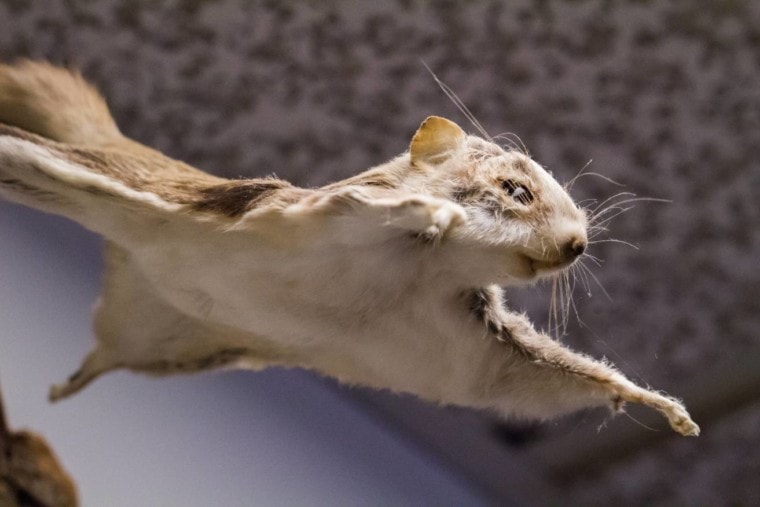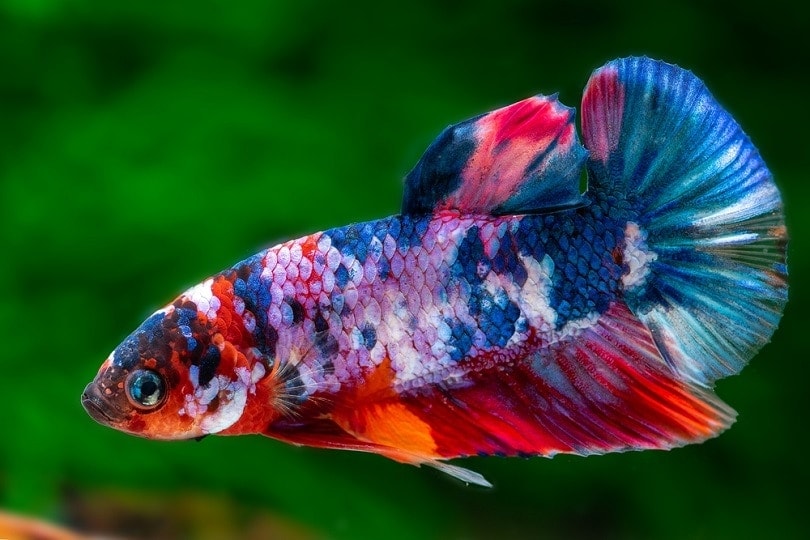
Click to Skip Ahead
Disclaimer: We do not endorse keeping these animals as pets
Flying squirrels are those adorable little furballs that you can observe, especially at night, in the coniferous forests of North America. One of the main characteristics that distinguish these small rodents is a furry membrane similar to a parachute: the patagium. There are two species native to North America: northern flying squirrels (Glaucomys sabrinus) and southern flying squirrels (Glaucomys volans). The southern species has an all-white belly and is smaller than its northern cousin—barely 8-10 inches long.
Not to be confused with sugar gliders, flying squirrels are increasingly attracting the attention of people looking for a “pocket animal” that is different from other more common rodents (such as guinea pigs and hamsters). But do they make good pets? They can make good pets as long as you are able to meet their specific needs adequately. That being said, we do not endorse keeping these animals as pets. What’s more, if you live in the United States, owning a flying squirrel in some states is illegal. You may need a special permit to acquire one, no matter what state you live in.
Are Flying Squirrels the Same as Sugar Gliders?

Flying squirrels and sugar gliders could be twins: both are tiny, fuzzy creatures that can glide between trees with their parachute-like membrane.
But, contrary to popular belief, the sugar glider (Petaurus breviceps) is not a rodent. Its resemblance to the flying squirrel is probably the origin of this belief.
Rather, it is a marsupial native to New Guinea and the east coast of Australia. In the wild, it lives in a group led by a dominant polygamous male. It feeds on the sap and gum of trees, the nectar of flowers, insects, and arachnids. Besides, the sugar glider is not easy to keep in captivity, as it needs a huge cage, a special diet, and sometimes has a more challenging character. However, for someone who wishes to invest fully to provide optimal captive conditions for this animal and who has a lot of time to devote to it, the sugar glider can be an endearing and unique animal.
On the flip side, flying squirrels are native to North America, are rodents, and are relatively easier to keep as pets than sugar gliders.
The 3 Reasons Flying Squirrels Make Good Pets
1. They become very attached to their humans.

Flying squirrels form an intense bond with their owners if acquired at a young age from a breeder. They are generally thrilled to spend time climbing and playing with their owner, much like you are a tree! But, on the other hand, their great sociability can cause a problem if you are not often at home: your little companion will not appreciate being alone for so long. So, if you plan to be away for long hours each day, acquiring a second flying squirrel would be necessary for the well-being of your little rodent.
2. They like to be carried around in your pocket.
Seriously, how adorable is that? Bonding pouches are essential for creating a strong bond between you and your baby flying squirrel and are often used throughout the squirrel’s life. Even though they are primarily nocturnal, flying squirrels can spend an entire day sleeping in their owner’s pockets. Indeed, they feel comfortable and secure, hidden in their sleeves or a pocket of their owner’s clothes.
3. They are one of the only mammals known to be fluorescent!
This spectacular feature doesn’t necessarily make flying squirrels better pets. Still, you have to admit that having a pet rodent that turns a glowing candy pink under UV rays is pretty impressive! Two biologists made the discovery of flying squirrel fluorescence by accident, as this study published in 2019 mentions. The exact function of this surprising feature is still unknown to scientists, but one of the theories is that it is a camouflage or imitation technique.
The 3 Things to Know Before Adopting a Flying Squirrel
Despite their exquisite charm and lovable personality, flying squirrels are not the right pets for everyone. Take the time to learn about their needs before acquiring them to ensure that you can provide them with the best living conditions.
1. They can bite
Flying squirrels have tiny sharp teeth that they use to shell nuts and seeds. Therefore, their bite can be painful, especially for small children. If your squirrel has been hand raised and is used to being handled daily, there is less chance that it will bite. But always keep in mind that tame or not, all animals can bite if they are afraid or provoked.

2. They require a lot of time investment
You will need to spend a lot of time with your flying squirrel, and ideally, always have it with you! This is probably one of the most important aspects to consider before acquiring this little animal due to the close bond it develops with its owner. In addition, flying squirrels can live up to 10 to 11 years in captivity, which is as much as many dog breeds. Are you ready to take care of your little rodent for so many years?
3. They are sometimes illegally traded
All cute and exotic little creatures are susceptible to illegal trafficking, and flying squirrels are unfortunately not spared. Baby flying squirrels are captured in their natural habitat and removed too young from the maternal nest, putting their lives at risk. Your responsibility here is to make sure you choose a reputable breeder and visit their facilities before acquiring your pet. Most importantly, never buy a baby flying squirrel online without knowing the breeder.
How to Care for Your Flying Squirrel
Housing
Although flying squirrels are tiny, they need a cage large enough for them to roam freely. A cage (ideally an aviary) of at least 5 feet high is necessary for your skillful little rodent to climb at ease. Do not forget to install several branches of trees (conifers if possible), to reproduce as closely as possible its natural habitat. You could also get a cage made for sugar gliders, but make sure the space between the meshes is not too large (1 inch at most). Also, install a nesting box at the top of the cage, where it can snuggle up to sleep. Finally, line the bottom of the cage with litter suitable for rodents.

Food
In the wild, flying squirrels feed on nuts, seeds, fruits, and insects. In captivity, they do well on a varied diet which may include:
Give the equivalent of about a tablespoon of food in the morning and evening. Since they are foragers, you can put a few small cups of food in places where you know the squirrel doesn’t defecate regularly. Remove any uneaten food after 12 hours. You can add hard-boiled eggs or chicken from time to time to increase the protein content of their diet. Southern flying squirrels also like to eat moths.
Since they are susceptible to calcium deficiency, supplement their diet with calcium and vitamin D3 (important in calcium metabolism). You can also provide a calcium block or cuttlefish bone; these dietary supplements serve as dental files because their teeth are continually growing.
Exercise
Flying squirrels are active creatures all year-round; therefore, they do not need to hibernate in winter, unlike other North American species. On the other hand, they are mainly nocturnal so they will be particularly active and playful at night. During the day, carry your animal with you in its pouch to strengthen your bond and get it used to your presence.
Note: Before you even think about adopting a flying squirrel, you’ll need to find a veterinarian who specializes in exotic animals. Indeed, it is not just any veterinarian who will agree to treat your particular rodent or who has the necessary skills. Flying squirrels have relatively robust health, but you will still need to have them checked and vaccinated annually.
Final Thoughts
Flying squirrels can make exciting and original pets, but they are also demanding animals. You need to have enough time to devote to them, have ample space to set up their cage and have access to a specialist veterinarian, among other things. If you’re up for the challenge, look for local animal shelters or breeders specializing in exotic animals. Finally, get ready to create a long-lasting bond with your adorable gliding creature!
Looking for more info on unusual pets? Try:
Featured Image Credit: Laura Fiorillo, Shutterstock








